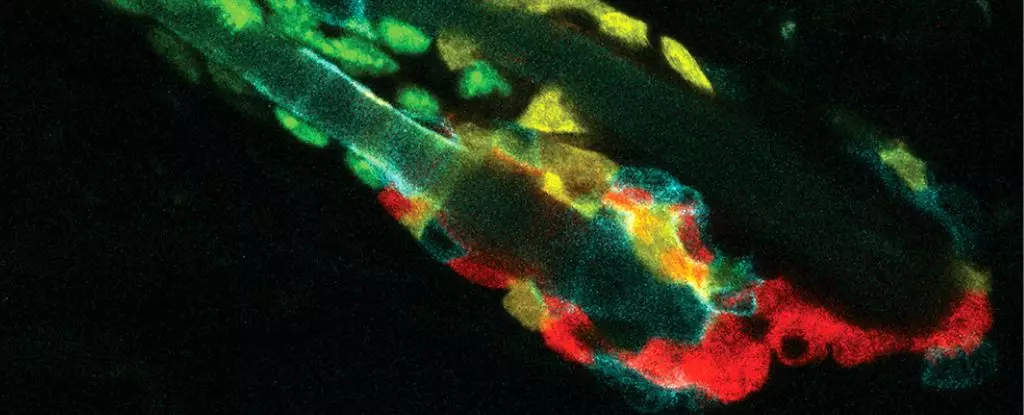Our bodies are remarkable organisms, constantly undergoing cellular processes that govern growth, healing, and overall function. Yet, with every second that ticks by, countless cells in our bodies perish—about a million a second, to be exact. This relentless cycle of death elicits a critical question: what happens to all the detached cellular debris? A groundbreaking study has shed light on an unexpectedly cannibalistic approach to this cleanup, revealing that neighboring viable stem cells take an active role in consuming their deceased counterparts.
Recent research conducted by a team in the United States focuses on the intricate interactions within the hair follicles of aging mice. The findings suggest that when hair follicle stem cells (HFSCs) die, it is often the living stem cells residing nearby that swiftly consume their fallen neighbors. This mechanism operates via the detection of two key biochemical signals, which act like sensory receptors tuned to the distinctive ‘smell’ of dying cells. Dr. Katherine Stewart, a cellular biologist at The Rockefeller University, explains that the system is contingent upon a delicate balance: “If one of the signals disappears, the cleanup process ceases.” This elegantly orchestrated system allows stem cells to maintain their environment while preventing the destructive inflammation that could emerge from an overactive immune response.
Among the mice studied, it was previously established that macrophages—immune cells responsible for clearing debris—would typically engage in cleaning after widespread cell death in the hair follicle region. However, the recent study unveiled a compelling twist: HFSCs were the initial responders in this cleanup operation. Surprisingly, these cells were adept at consuming not just one, but potentially up to six neighboring dead cells. This scavenging behavior serves a dual purpose: not only does it clear away the dead matter, but it might also provide a source of energy, helping to ensure the longevity and maintenance of the remaining stem cell population.
The implications of this study extend far beyond mere cellular scavenging. By understanding this unique system, researchers may begin to uncover strategies for tissue regeneration and repair in humans. Elaine Fuchs, another pivotal figure in this research, posits that this consumption of dead cells could ultimately be harnessed as a means to recycle resources, promoting both energy efficiency and cellular resilience.
Furthermore, the research highlights the advanced capabilities of these HFSCs, which embody a certain elegance in their operational design—the signaling processes can be likened to ‘on’ and ‘off’ switches. One receptor is triggered by dying cells, sending out a ‘find me’ lipid signal, while another responds to growth-promoting retinoic acid from neighboring healthy cells. This dynamic communication leads to a finely-tuned response where cleanup is initiated in the presence of dying cells, and the system subsides when no further cleanup is required.
The researchers’ findings still leave several avenues for exploration open. While much has been revealed about the HFSCs in mice, it raises an interesting question regarding whether similar mechanisms exist in other tissues across mammalian biology. The subtle interplay between stem cell health and cellular death could provide insight into age-related degeneration and various diseases where inflammation plays a pivotal role. Future research may thus focus on analyzing this phenomenon within different tissues, paving the way for potentially transformative applications in regenerative medicine and therapeutic interventions.
In essence, the study sheds light on an astonishing and sophisticated means by which our bodies deal with cellular death. Rather than relying solely on immune cells, living stem cells have developed a method of cannibalism that ensures their environment remains clear of debris, promoting both cellular health and longevity. As research continues to evolve, our comprehension of cellular mechanisms and their implications for human health will undoubtedly deepen, reminding us once more of the profound intricacies of our biological systems.



Leave a Reply